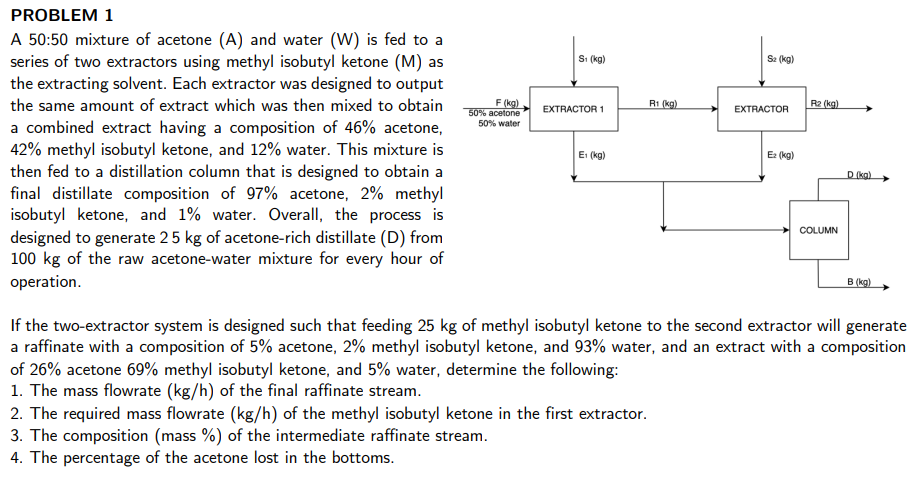PROBLEM A 50:50 mixture of acetone (A) and water (W) is fed to a series of two extractors using methyl isobutyl ketone (M) as the extracting solvent. Each extractor was designed to output S kg) Se (kg) the same amount of extract which was then mixed to obtain Fkg) 50% acetone R1 (kg) R2 (kg) EXTRACTOR 1 EXTRACTOR a combined extract having a composition of 46% acetone, 42% methyl isobutyl ketone, and 12% water. This mixture is then fed to a distillation column that is designed to obtain a final distillate composition of 97% acetone, 2% methyl isobutyl ketone, and 1% water. Overall, the process is designed to generate 25 kg of acetone-rich distillate (D) from 100 kg of the raw acetone-water mixture for every hour of 50% water E (kg) E (kg) COLUMN operation. 3 (kg) If the two-extractor system is designed such that feeding 25 kg of methyl isobutyl ketone to the second extractor will generate a raffinate with a composition of 5% acetone, 2% methyl isobutyl ketone, and 93% water, and an extract with a composition of 26% acetone 69% methyl isobutyl ketone, and 5% water, determine the following: 1. The mass flowrate (kg/h) of the final raffinate stream. 2. The required mass flowrate (kg/h) of the methyl isobutyl ketone in the first extractor. 3. The composition (mass %) of the intermediate raffinate stream. 4. The percentage of the acetone lost in the bottoms.
PROBLEM A 50:50 mixture of acetone (A) and water (W) is fed to a series of two extractors using methyl isobutyl ketone (M) as the extracting solvent. Each extractor was designed to output S kg) Se (kg) the same amount of extract which was then mixed to obtain Fkg) 50% acetone R1 (kg) R2 (kg) EXTRACTOR 1 EXTRACTOR a combined extract having a composition of 46% acetone, 42% methyl isobutyl ketone, and 12% water. This mixture is then fed to a distillation column that is designed to obtain a final distillate composition of 97% acetone, 2% methyl isobutyl ketone, and 1% water. Overall, the process is designed to generate 25 kg of acetone-rich distillate (D) from 100 kg of the raw acetone-water mixture for every hour of 50% water E (kg) E (kg) COLUMN operation. 3 (kg) If the two-extractor system is designed such that feeding 25 kg of methyl isobutyl ketone to the second extractor will generate a raffinate with a composition of 5% acetone, 2% methyl isobutyl ketone, and 93% water, and an extract with a composition of 26% acetone 69% methyl isobutyl ketone, and 5% water, determine the following: 1. The mass flowrate (kg/h) of the final raffinate stream. 2. The required mass flowrate (kg/h) of the methyl isobutyl ketone in the first extractor. 3. The composition (mass %) of the intermediate raffinate stream. 4. The percentage of the acetone lost in the bottoms.
Introduction to Chemical Engineering Thermodynamics
8th Edition
ISBN:9781259696527
Author:J.M. Smith Termodinamica en ingenieria quimica, Hendrick C Van Ness, Michael Abbott, Mark Swihart
Publisher:J.M. Smith Termodinamica en ingenieria quimica, Hendrick C Van Ness, Michael Abbott, Mark Swihart
Chapter1: Introduction
Section: Chapter Questions
Problem 1.1P
Related questions
Question

Transcribed Image Text:PROBLEM 1
A 50:50 mixture of acetone (A) and water (W) is fed to a
series of two extractors using methyl isobutyl ketone (M) as
the extracting solvent. Each extractor was designed to output
the same amount of extract which was then mixed to obtain
Si (kg)
Sa (kg)
F (kg)
50% acetone
RI (kg)
R2 (kg)
EXTRACTOR 1
EXTRACTOR
a combined extract having a composition of 46% acetone,
42% methyl isobutyl ketone, and 12% water. This mixture is
then fed to a distillation column that is designed to obtain a
final distillate composition of 97% acetone, 2% methyl
isobutyl ketone, and 1% water. Overall, the process is
designed to generate 25 kg of acetone-rich distillate (D) from
100 kg of the raw acetone-water mixture for every hour of
50% water
Ei (kg)
E (kg)
D (ka)
COLUMN
operation.
B (kg)
If the two-extractor system is designed such that feeding 25 kg of methyl isobutyl ketone to the second extractor will generate
a raffinate with a composition of 5% acetone, 2% methyl isobutyl ketone, and 93% water, and an extract with a composition
of 26% acetone 69% methyl isobutyl ketone, and 5% water, determine the following:
1. The mass flowrate (kg/h) of the final raffinate stream.
2. The required mass flowrate (kg/h) of the methyl isobutyl ketone in the first extractor.
3. The composition (mass %) of the intermediate raffinate stream.
4. The percentage of the acetone lost in the bottoms.
Expert Solution
This question has been solved!
Explore an expertly crafted, step-by-step solution for a thorough understanding of key concepts.
This is a popular solution!
Trending now
This is a popular solution!
Step by step
Solved in 5 steps with 14 images

Recommended textbooks for you

Introduction to Chemical Engineering Thermodynami…
Chemical Engineering
ISBN:
9781259696527
Author:
J.M. Smith Termodinamica en ingenieria quimica, Hendrick C Van Ness, Michael Abbott, Mark Swihart
Publisher:
McGraw-Hill Education

Elementary Principles of Chemical Processes, Bind…
Chemical Engineering
ISBN:
9781118431221
Author:
Richard M. Felder, Ronald W. Rousseau, Lisa G. Bullard
Publisher:
WILEY

Elements of Chemical Reaction Engineering (5th Ed…
Chemical Engineering
ISBN:
9780133887518
Author:
H. Scott Fogler
Publisher:
Prentice Hall

Introduction to Chemical Engineering Thermodynami…
Chemical Engineering
ISBN:
9781259696527
Author:
J.M. Smith Termodinamica en ingenieria quimica, Hendrick C Van Ness, Michael Abbott, Mark Swihart
Publisher:
McGraw-Hill Education

Elementary Principles of Chemical Processes, Bind…
Chemical Engineering
ISBN:
9781118431221
Author:
Richard M. Felder, Ronald W. Rousseau, Lisa G. Bullard
Publisher:
WILEY

Elements of Chemical Reaction Engineering (5th Ed…
Chemical Engineering
ISBN:
9780133887518
Author:
H. Scott Fogler
Publisher:
Prentice Hall


Industrial Plastics: Theory and Applications
Chemical Engineering
ISBN:
9781285061238
Author:
Lokensgard, Erik
Publisher:
Delmar Cengage Learning

Unit Operations of Chemical Engineering
Chemical Engineering
ISBN:
9780072848236
Author:
Warren McCabe, Julian C. Smith, Peter Harriott
Publisher:
McGraw-Hill Companies, The